ABSTRACT
The objective is to analyze the perception that the residents of Fort Irwin have about the city of Tijuana. For this quantitative methodology, a survey was applied to 260 inhabitants of Fort Irwin, and the instrument consists of four dimensions: general data, characteristics, services and perception of Tijuana. Results: the elements that motivate the citizens of Fort Irwin to visit Tijuana are the weather, the variety of cultural and outdoor activities and gastronomy but the negative aspects are the insecurity and lack of cleanliness in the city. Conclusion: the factors of safety, public services and gastronomy are those that are related in greater incidence with the image of the city of Tijuana.
KEYWORDS
IMAGE OF THE CITY, TIJUANA, FORT IRWIN, TOURISM.
RESUMEN
El objetivo es analizar la percepción que tienen los residentes de Fort Irwin acerca de la ciudad de Tijuana. Para esta metodología cuantitativa, se aplicó una encuesta a 260 habitantes de Fort Irwin, y el instrumento consta de cuatro dimensiones: datos generales, características, servicios y percepción de Tijuana. Resultados: los elementos que motivan a los ciudadanos de Fort Irwin a visitar Tijuana son el clima, la variedad de actividades culturales y al aire libre, la gastronomía, pero los aspectos negativos son la inseguridad y la falta de limpieza en la ciudad. Conclusión: los factores de seguridad, servicios públicos y gastronómicos son los que se relacionan en mayor incidencia con la imagen de la ciudad de Tijuana.
PALABRAS CLAVES
IMAGEN DE CIUDAD, TIJUANA, FORT IRWIN, TURISMO
RÉSUMÉ
L’objectif est d’analyser la perception qu’ont les résidents de Fort Irwin au sujet de la ville de Tijuana. Pour cette méthodologie quantitative, un sondage a été appliqué à 260 habitants de Fort Irwin, et l’instrument comporte quatre dimensions: données générales, caractéristiques, services et perception de Tijuana. Résultats: les éléments qui motivent les habitants de Fort Irwin à visiter Tijuana sont le climat, la variété d’activités culturelles et à l’air libre et la gastronomie, mais les aspects négatifs sont l’insécurité et le manque de propreté dans la ville. Conclusion : les facteurs de sécurité, des services publics et gastronomiques sont ceux qui ont le plus d’incidence sur l’image de la ville de Tijuana.
MOTS CLES
IMAGE DE LA VILLE, TIJUANA, FORT IRWIN, TOURISME.
RESUMO
O objetivo é analisar a percepção que os moradores de Fort Irwin têm acerca da cidade de Tijuana. Para essa metodologia quantitativa, foi aplicada uma enquete a 260 habitantes do Fort Irwin, e o instrumento consta de quatro dimensões: dados gerais, características, serviços e percepção de Tijuana. Resultados: os elementos que motivam os cidadãos de Fort Irwin a visitar Tijuana são o clima, a variedade de atividades culturais e ao ar livre, a gastronomia, mas os aspectos negativos são a insegurança e a falta de limpeza na cidade. Conclusão: os fatores de segurança, serviços públicos e gastronômicos são os que se relacionam em maior incidência com a imagem da cidade de Tijuana.
PALABRAS CHAVE
IMAGEM DA CIDADE, TIJUANA, FORT IRWIN, TURISMO.
INTRODUCTION
According to the World Tourism Organization (UNWTO), the tourism industry is one of the most important activities in the world. In the last six decades, it has undergone continuous expansion and diversification, becoming one of the sectors with more significant development. The emergence of new destinations of interest to travelers has been fundamental to socio-economic progress, promoting the creation of jobs and companies, which, in turn, need to encourage new technological infrastructures and adapt to new needs and environmental demands (UNWTO, 2017). Despite the problems in various regions of the planet, this sector registers a continuous expansion over time; this demonstrates its strength and resilience. It should be noted that leisure travel and air transport dominate international tourism (UNWTO, 2019).
For its part, Mexico is among the top 10 destinations in the world, receiving 40% of tourist arrivals (UNWTO, 2019). It should be noted that tourism is one of the sectors of the economy that contributes the most to the country's Gross Domestic Product (GDP) and that it has maintained a constant growth rate given that Mexico is considered an attractive territory for travelers from all over the world (INEGI, 2019; Rodríguez-Brindis, 2014). Tourism has become a determining factor in the design of economic and social policy, so much so that it always has an important place in Mexico's development plan in order to take advantage of its contribution to the national and regional economy. In this way, the ideal conditions will be created for other sectors to join and take advantage of this indirect impact, thus integrating a more complete industry in the well-being of the different places preferred by tourists (Rodríguez-Brindis, 2014).
This research takes the city of Tijuana as a reference. Tijuana is part of the five municipalities that make up the State of Baja California, Mexico, which borders the north with California, United States. Tijuana has the largest infrastructure in accommodation, restaurants, and recreation centers in Baja California, as well as a significant flow of national and foreign visitors who arrive for various reasons in this city, located in the northwest of the country (INEGI, 2017). The tourist offers and services that stand out in the metropolitan area of this region are sunny beach areas; urban tourism; business tourism; gastronomy; health tourism, among others (SECTUR, 2015).
Unfortunately, due to criminal acts and violent incidents in Baja California, the image of Tijuana is affected. The perception of insecurity and fear that United States citizens have upon arriving in Mexico is due to the constant conflicts caused by the confrontations of the Mexican government in the fight against drug trafficking (Enríquez-Acosta, Meza & Fierro, 2015). In addition, the State Department of the neighboring country warns Americans about the risk of traveling to certain areas in Mexico due to the activities of criminal organizations. It places Tijuana as one of the regions where tourists should be more cautious due to the high crime rates in the city (US-Department-of-State, 2019).
As for the National Training Center (NTC), Fort Irwin is a designated place for the military reserves of the Armed Forces of the United States. It is located in San Bernardino County, between Las Vegas, Nevada, and Los Angeles, California, within the State of California. It has a population of 9,053 inhabitants (DATA-USA, 2019) who reside there seasonally, in other words, families that come from different cities in the United States. Since it is located in the middle of the desert and 35 miles from the city of Barstow, residents do not have many options for family recreation (Militarybases.US, 2019). This case study was carried out given the continuous rotation of people who come to live in this town. The research was conducted in 2019 and aimed to analyze the perception that residents of Fort Irwin have about Tijuana as an attractive destination to visit and the image they have of this city in the State of Baja California.
LITERATURE REVIEW
Mexico has stood out for being one of the most favorite tourist places in the world, even despite insecure situations that have been occurring in the country and made the news all over the planet. In 2018 it ranked number 7 worldwide for the arrival of international tourists, which amounted to 41.3 million people. Likewise, in terms of the inflow of international currencies, it ranked number 16, amounting to 22 thousand 526 million dollars (SECTUR, 2018). The tourism sector on the border is of great importance for the country's economic development (Lee & Wilson, 2015).
Currently, countries are constantly concerned about the image they project in international markets, given that they have adopted and implemented differentiation strategies to stimulate tourism and economic investment (Cervantes, 2018). According to studies carried out by the UNWTO (2017), tourism revenues have been rising with more notoriety in nations that have managed to establish their brands for their tourist attractions, such as Spain, France, or the United Kingdom.
City Image
Since the 70s, cities have competed in various world regions to attract investors, tourists, and new residents. The opening of markets, the revaluation of private capital and the emergence of governance in urban management are elements that favor determining the positioning of the localities (Castro-Villar, 2016). The images that are constructed to represent each site make it easier to distinguish one place from another. In this way, each location manifests itself in terms of thinking, feeling, associating, perceiving, and informing the visitor and the target market they seek to attract (Castro, Palacios, & Plazarte, 2020; León, Blanco, & Victoria, 2018).
Images are conceived; they are not only a means of expression and the prescription of meanings, they are a universal language, as well as a natural and spontaneous way of relating to others. Thus, we must analyze the construction of visual images in order to understand the act of seeing and the mechanisms of visual thought (Cantón-Correa & Alberich-Pascual, 2019). The image of a city that each person draws in their thought is not endless, fixed and static; it is rather fragmented, partial, with a mixture of concerns that each individual is forging over time based on experience or obtained information. The variables conceived can remain stable for a certain time, but the surrounding details are the object that drives the change of this ideology in the medium and long term (León et al., 2018).
The three attributes that support the constructed image of any destination are the holistic, psychological-functional, and common-unique attributes (Gallarza, Gil-Saura, & Calderón, 2002). Likewise, the details are produced with the mixture of elements that are projected in each community. The constructions, natural spaces, the aspects of urbanization, and culture must be used to appropriately communicate the advantages intended to stand out (Aladro & Mosquera, 2018). The participation of the private sector and the practices of organizations in urban management sometimes cause cities to be guided only by the criterion of competitiveness. However, for their attractiveness to last for many years, it is necessary that these cities have a set of tools that differentiate them and that make them attractive places to invest, travel, work, and live. In this way, it is possible to easily manage the image of each locality (Castillo-Villar, 2016).
In this way, for a destination to be recognized in a competitive market, its image must highlight certain elements that attract the attention and the desires of travelers to get to know the place (Castro et al., 2020). These components must be favorable so that the city or town differentiates itself from the competition, in turn leading it to position itself in people's minds (Stepchenkova & Li, 2014). The components, which are made up of individual and holistic attributes, contain tangible (functional) and intangible (psychological) variables that can change based on the characteristics that identify each place and with those that people associate with them (Kislali, Kavaratzis, & Saren, 2016).
The image of the destination in terms of the holistic attribute is made up of information sources, natural and cultural resources, as well as characteristics and attributes of the visitor. The functional-psychological element is related to the infrastructure-environment, socio-economic structure, and visitor experience. The common-unique attribute verifies the unique image of the place (Castro et al., 2020). Therefore, the conjugation of these elements allows the tourist to channel their expectations into the preconceived idea of the place they visit. Retail trade constitutes a key strategic variable for this because tourists have needs and desires to buy at various points sales with which they complete their experience (González-Morales & Pons-García, 2013).
The citizen is the primary consumer and source of information to determine the quality of the urban image of a city. It is essential to consider that every consumer has a level of expectation towards the determined product and that after consumption there will be a particular level of satisfaction (Valdivia, 2014). Crime and situations of corruption in the government are capable of changing tourist flows, prompting people to prefer other places due to the hostile conditions of the destination (Sánchez & Cruz, 2017). Likewise, these situations reinforce the spreading of comments and tabloid or sensational articles that can quickly change travelers' positive perceptions towards the town (Enríquez-Acosta et al., 2015).
The offer of the city of Tijuana presents a series of deficiencies concerning service quality and price, which, in turn, weakens the incursion of specialized shifts and modifications in the city's image. The negative diffusion of these deficiencies can result in weaknesses in the image and conditions of the destination, together with the well-known perception of insecurity that has haunted this municipality of the State of Baja California for many years (SECTUR, 2015). It should be noted that the attraction of investment and the development of sophisticated infrastructures are not the main component to improve the image. It is a matter that also requires the participation of the government, the private sector, and citizens, as each must obtain a benefit that inspires the desire to improve the perception that is held by people outside the city (Castro-Villar, 2016).
Aspects of a destination that stand out become iconic components that visitors identify over time. They, in turn, share their experience so that other people broaden their expectations through these factors (Kido, Díaz-Carrión, & Kido, 2018). These references and anticipated travelers' attitudes can take a negative turn when they learn about the crime that prevails in the places they want to visit through different media. These negative turns of perceptions are common in border regions such as Tijuana, where even the flow of tourism itself can be considered a factor that favors this unfortunate result in the city's image (Biagi & Detott, 2014).
Fort Irwin
National Training Center (NTC), or known simply as Fort Irwin, is a United States military reservation site in San Bernardino County in the State of California. It is located 190 miles or less than four hours by road from Tijuana/San Diego. Fort Irwin can be accessed by Interstates 40 and 15 and State Highways 58 and 247. It has a population of 9,053 inhabitants (DATA-USA, 2019), who reside three years in Fort Irwin and have fixed vacations three times a year. They are citizens from different parts of the United States.
As Fort Irwin is a national training base, the residents are primarily soldiers over thirty years of age who live with their families on the base. Because it is located in the middle of the desert and approximately 35 miles or 40 minutes from the first city (Barstow), residents do not have many options for family recreation (Militarybases.US, 2019). In addition, they have four days off each end of rotation, and they have high economic purchasing power.
The city of Tijuana has been cataloged for some decades with an image of insecurity by various national and international media. Concerning events in North American society as a result of September 11 have harmed the perception of this border (Santos, 2014; Enríquez-Acosta et al., 2015). For its part, the geographical location of Tijuana allows it to be identified as the most important border crossing in the world, being one of the most attractive places for tourists to visit in Mexico (Santos, 2014). The analysis of the perceived image of a city is fundamental to know the areas that must be supported and improved, as well as to know the negative aspects to later reduce them with the assistance of the citizens and government agencies interested in changing the perception that tourists have of the destination (Castillo-Villar, 2016). In the case of Tijuana, it must have a brand that reflects the reality and interests of its inhabitants beyond its commercial position. In this context, comprehensive communication can be used to create and manage the image that must be reflected (Gómez & Salinas, 2017). To make a city an attractive destination for a sector, it is necessary that the resources, strategies, and trajectories of each urban entity, as well as the condition that highlights the destination itself, are delimited to particular ways of conceiving and are settled in modernity (Hernández- Pulgarín, 2015).
METHODOLOGY
The methodology used for this research consisted of, first of all, conducting a literature review to obtain information based on the perception of the city of Tijuana and the characteristics of the population of Fort Irwin. In the next phase of the research, the quantitative survey technique was used, which was directed to Fort Irwin residents to find out which elements favor the intention of visiting this border city. The total population is 9,053 inhabitants (DATA-USA, 2019), the sample size was obtained through the statistical formula for finite population, based on 95% confidence and 6% admitted error (Fischer & Espejo, 2017; Malhotra, 2008). The survey was carried out in November 2019 using the probabilistic sampling technique to 260 inhabitants of this community who have visited Tijuana. The instrument comprises four dimensions: general data constituted by open questions, evaluation of the characteristics of the city of Tijuana, perception of Tijuana, and assessment of the services of Tijuana. The last three dimensions were measured by the Likert scale (see table 1).
| Dimension | Number of items | Type of question |
|---|---|---|
| General information: Age, gender, marital status, place of origin, level of studies, member of the Army. | 6 | Open |
| Evaluation of the characteristics of the city of Tijuana | 14 | Likert scale |
| Perception of Tijuana personality traits: Safe, clean, sociable, etc. | 18 | Likert scale |
| Evaluation of the services of the city of Tijuana | 7 | Likert scale |
Source: own elaboration
As for the reliability analysis of the instrument, it was performed using Cronbach's alpha using the SPSS 20 program. According to Hernández, Fernández & Baptista (2014) and Hinton, McMurray & Brownlow (2014), reliability greater than 0.5 is considered acceptable. For the instrument's reliability (see table 2), the questions that refer to the evaluation of the characteristics of the city of Tijuana were grouped. A coefficient of 0.928 (acceptable reliability) was obtained. As for the reliability reviewed concerning the perception of the personality traits of Tijuana, a coefficient of 0.957 (acceptable reliability) was obtained.
| Evaluation of the characteristics of the city of Tijuana | Perception of Tijuana personality traits | ||
|---|---|---|---|
| Cronbach alpha | Number of elements | Cronbach alpha | Number of elements |
| 0.928 | 14 | 0.957 | 18 |
Source: own elaboration
RESULTS
As for the age of the respondents: 34.2% are from 27 to 34 years old, 33.1% are from 19 to 26 years old, 25.4% are 35 to 42 years of age (see figure 1).
Figure 1 Age of Fort Irwin Resident Respondents
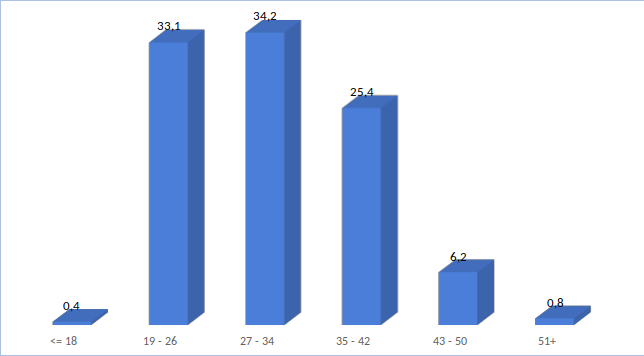
Regarding the opinion of the characteristics of the city of Tijuana (see figure 2). On a scale of 1 to 5, with 1 being terrible and 5 excellent (see figure 1), climate got a score of 3.5, gastronomic options 3.3, variety of outdoor activities 3.3, public places such as museums and parks 3.1, and the friendliness of the city inhabitants 3.2.
Figure 2 Evaluation of the characteristics of the city of Tijuana
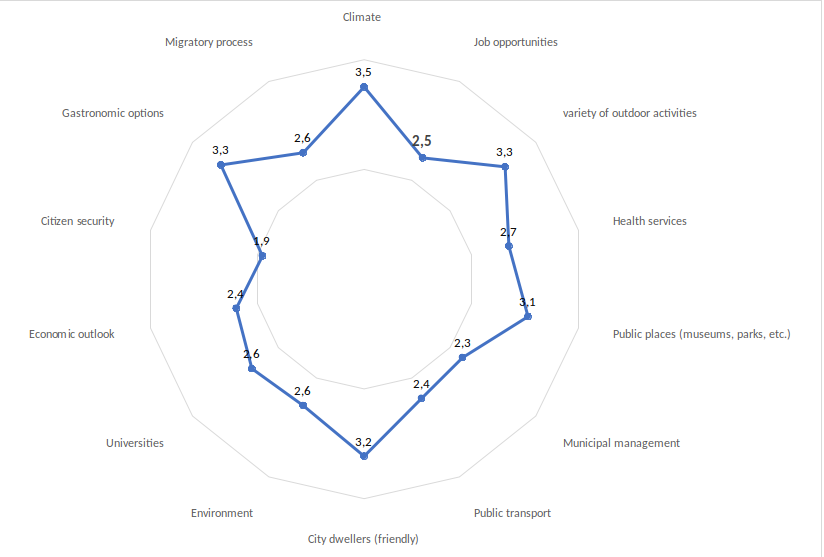
In figure 3, the personality of the city of Tijuana is shown. On a scale from 1 (terrible) to 5 (excellent), the inhabitants of Fort Irwin considered the border city honest, fun, recreational, friendly, accessible, resistant, economical, and productive.
Figure 3 Personality of the city of Tijuana
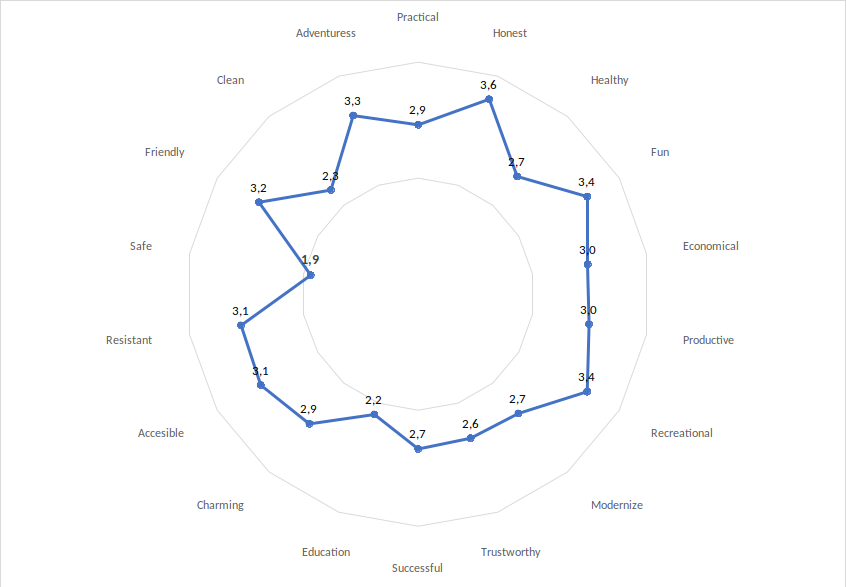
Regarding the evaluation of the services offered by Tijuana on a scale from 1 to 7, with 1 being the lowest score and 7 being the highest score, Fort Irwin residents evaluated cultural services with a score of 5.1, followed by nightlife 4.6, recreational and gastronomic services with the same score 4.1, medical services 3.7, sports 3.6, and meetings and businesses (2.7) (see figure 4).
Figure 4 Evaluation of the services of the city of Tijuana
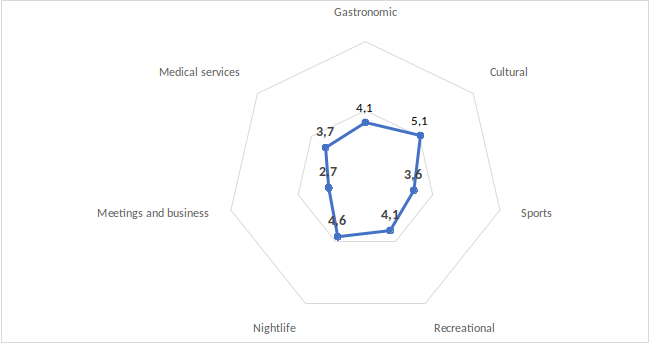
The residents of the Fort Irwin military base have heard about the city of Tijuana (see figure 5) through friends or family (33.5%), television (29.6%), and movies that are shown to the Fort Irwin military as part of their training 15.8%, and only 7.7% have visited the border town.
Figure 5 Evaluation of the services of the city of Tijuana
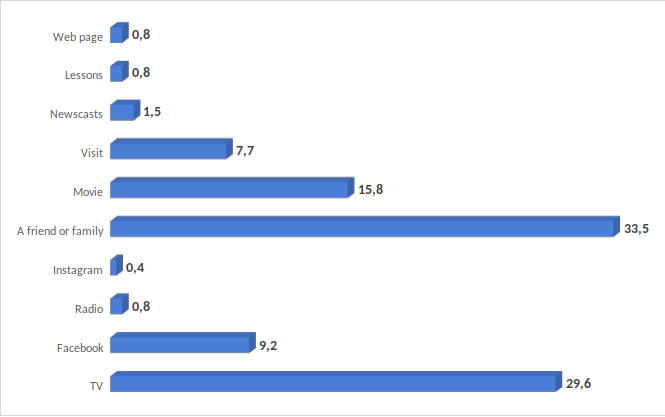
REFERENCIAS
Aladro, J. M., & Mosquera, E. (2018). La Imagen Industrial De La Ciudad. Jerez De La Frontera Siglo XIX. Revista de EGA, 23(32), 254–261. Obtenido de https://doi.org/10.4995/ega.2018.9815
Biagi, B., & Detott, C. (2014). Crime as Tourism Externality. Regional Studies, 48(4), 693–709. doi: https://doi.org/10.1080/00343404.2011.649005
Cantón-Correa, F. J., & Alberich-Pascual, J. (2019). Construcción social de la imagen de una ciudad a través de Instagram: el caso de Granada. El Profesional de La Información, 28(1), 1–12. doi:https://doi.org/10.3145/epi.2019.ene.08
Castillo-Villar, F. R. (2016). Alcances y límites de la marca ciudad en la gestión de la imagen de la ciudad. Revista Venezolana de Gerencia, 157-171. Obtenido de https://www.redalyc.org/pdf/290/29045347010.pdf
Castro, J. C., Palacios, J. M., & Plazarte, L. V. (2020). Imagen Del Destino Desde La Perspectiva Del Turista. Turismo y Sociedad(26), 45-66. doi:https://doi.org/10.18601/01207555.n26.02
Castro-Villar, F. R. (2016). Alcances y límites de la marca de ciudad en la gestión de la. Utopia y Praxis Latinoamericana, 21(73), 157–171. Obtenido de http://search.ebscohost.com/login.aspx?direct=true&db=zbh&AN=115815697&lang=es&site=ehost-live
Cervantes, J., (2018). Impacto de la imagen de México en el turismo y las inversiones: Evidencias contradictorias. ANFECA. Obtenido de http://congreso.investiga.fca.unam.mx/docs/xxi/docs/14.06.pdf
DATA-USA. (2019). Fort Irwin, CA. Obtenido de Population: https://datausa.io/profile/geo/fort-irwin-ca
Enríquez-Acosta, J. A., Meza, A., & Fierro, N. (2015). Inseguridad y Crisis Económica en el Imaginario Social de Playas de Rosarito, Baja California. PASOS, 463-475. doi:https://doi.org/10.25145/j.pasos.2015.13.033
Fischer, L., & Espejo, J. (2017). Introducción a la investigación de mercados. México: McGraw-Hill.
Gallarza, M. G., Gil-Saura, I., & Calderón, H. (2002). Destination image: Towards a Conceptual Framework. Annals of Tourism Research, 29(1), 56-78. doi:https://doi.org/10.1016/S0160-7383(01)00031-7
Gómez, J. S., & Salinas, J. (2017). Comunicación integral en construcción de marcas ciudad: aportes, tensiones y desafíos integral. Prisma Social(19), 368-387. Obtenido de https://revistaprismasocial.es/article/view/1744
González-Morales, D., & Pons-García, R. C. (2013). Imagen: variable estratégica del comercio minorista y del destino turístico. Retos Turísticos, 12(2), 12–22. Obtenido de http://search.ebscohost.com/login.aspx?direct=true&db=zbh&AN=108725609&lang=es&site=ehost-live
Hernández-Pulgarín, G. (2015). Imagen e ideología en el gobierno de la ciudad. Los casos de Montpellier (Francia) y Pereira (Colombia). Cuaderno urbano, 19(19), 73-94. Obtenido de http://190.15.17.25/kepes/downloads/Revista18_10.pdf
INEGI. (2017). Anuario estadístico y geográfico de Baja California. México: Instituto Nacional de Estadística y Geografía. Obtenido de https://www.datatur.sectur.gob.mx/ITxEF_Docs/BCN_ANUARIO_PDF.pdf
INEGI. (2019). Comunicado de Prensa Núm. 700/19. Ciudad de México: Instituto Nacional de Estadística y Geografía. Obtenido de https://www.inegi.org.mx/contenidos/saladeprensa/boletines/2019/StmaCntaNal/CST2018.pdf
Kido, M. T., Díaz-Carrión, I. A., & Kido, A. (2018). La satisfacción del comensal como elemento clave del binomio gastronomía-turismo en Tijuana. Estudios Sociales: Revista de Investigación Científica, 28(51), 1–29. doi:https://doi.org/10.24836/es.v28i51.499
Kislali, H., Kavaratzis, M., & Saren, M. (2016). Rethinking destination image formation. International Journal of Culture, Tourism and Hospitality Research, 10(1), 70-80. doi:https://doi.org/10.1108/IJCTHR-05-2015-0050
Lee, E. & Wilson, C. (2015). La economía fronteriza México-Estados Unidos en transición. Obtenido de http://naresearchpartnership.org/wp-content/uploads/2013/07/La-Econom%C3%ADa-de-la-Frontera-MX-EEUU-en-Transici%C3%B3n.pdf
León, L., Blanco, R., & Victoria, K. (2018). Significación Del Espacio Barrial Como Imagen De Ciudad: El Caso De Pescaíto, Santa Marta. Andamios(38), 39–64. Obtenido de http://search.ebscohost.com/login.aspx?direct=true&db=zbh&AN=136489881&lang=es&site=ehost-live
Malhotra, N. K. (2008). Investigación de mercados (5a. ed.). México: Pearson.
Militarybases.US. (2019). Fort Irwin: Location. Obtenido de http://www.militarybases.us/army/fort-irwin/
OMT. (2017). Panorama del Turismo Internacional. Madrid, España: Organización Mundial del Turismo. Obtenido de https://www.e-unwto.org/doi/pdf/10.18111/9789284419043
OMT. (2019). Panorama del Turismo Internacional. Madrid, España: Organización Mundial del Turismo. Obtenido de https://www.e-unwto.org/doi/pdf/10.18111/9789284421237
Rodríguez-Brindis, M. A. (2014). La contribución del Turismo al crecimiento económico de México: Un análisis por ramas características del sector. Nova scientia, 7(13), 337 – 351. Obtenido de http://www.scielo.org.mx/scielo.php?script=sci_arttext&pid=S2007-07052015000100018
Sánchez, F., & Cruz, J. N. (2017). Excursionismo internacional y secuestros en la frontera de México, 1997 - 2016. Revista de Relaciones Internacionales, Estrategia y Seguridad, 12(1), 237-266. doi:https://doi.org/10.18359/ries.2471
Santos, H. (2014). Tijuana la Horrible: Entre la historia y el mito, Tijuana. Relaciones: Estudios de historia y sociedad, 35(138), 272-277. Obtenido de https://dialnet.unirioja.es/servlet/articulo?codigo=5319011
SECTUR. (2015). Agendas de Competitividad del destino turístico de Tijuana, B.C. México. Baja California: Secretaría de Turismo de México. Obtenido de http://www.sectur.gob.mx/wp-content/uploads/2015/02/PDF-Tijuana.pdf
SECTUR. (2018). Compendio estadístico del turismo en México. México: DATATUR. Obtenido de https://www.datatur.sectur.gob.mx/SitePages/CompendioEstadistico.aspx
SECTUR. (2019). El turismo: actividad con más crecimiento en la economía nacional. Ciudad de México: Secretaría de Turismo de México. Obtenido de https://www.gob.mx/sectur/prensa/el-turismo-es-una-de-las-actividades-con-mas-crecimiento-en-la-economia-nacional
Stepchenkova, S., & Li, X. (2014). Destination image: Do top-of-mind associations say it all? Annals of Tourism Research(45), 46-62. doi:https://doi.org/10.1016/j.annals.2013.12.004
U.S.-Department-of-State. (2019). Mexico Travel Advisory. Obtenido de https://travel.state.gov/content/travel/en/traveladvisories/traveladvisories/mexico-travel-advisory.html
Valdivia, A. (2014). La calidad de la imagen urbana. Categorías visuales del estado estético de Comas. Revista Bitácora Urbano Territorial, 24(2), 31-43. Obtenido de https://revistas.unal.edu.co/index.php/bitacora/article/view/38634/pdf_30
